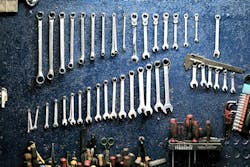What Operators Should Know About Modern Piston Ring Design
Fuel efficiency through reduced friction is a big part of engine design, as automakers look for every way to increase MPGs.
That’s seen in wider use of low-viscosity engine oils, but it’s also in engine parts like low-tension piston rings. Particularly in direct-injection engines, contaminants can blow past this kind of piston ring and lead to carbon buildup.
NOLN columnist Kit Sullivan previously summed up the cycle of problems that could persist as a result. He said that carbon deposits, “will lead to poor engine oil control, which manifests itself as high oil consumption. Dirty rings can also exacerbate blow-by of gasoline and combustion byproducts into the oil, contaminating it very early in its life cycle. Carbon deposits on the pintle-end of the fuel-injector tips lead to poor fuel atomization and poor combustion. Loss of power and poor fuel economy are the most noticeable results of dirty fuel injectors.”
Steve Muth, the chief chemist for additive manufacturer Penray Inc., a supplier of chemicals, additives and functional fluids to quick lubes and other automotive service providers, shared more information about low-tension piston rings with NOLN, and he explained how quick lube operators can be aware of the related issues to help customers.
As told to Matt Hudson
A primer on low-tension piston rings
Engineers and engine builders have known for years that piston rings account for the bulk of the friction in internal combustion engines—as much as 75 percent in some cases.
So, the use of lower-tension piston rings can have a significant effect on engine friction and, accordingly, engine efficiency. In fact, race engine builders typically specify low tension compression and oil control rings for their engine builds. The trade-off is greater oil consumption and reduced piston ring life in exchange for reduced friction and more power in race cars.
By their very nature, lower-tension compression and oil control rings have reduced ability to spring back into shape and into position when tiny bits of debris or sludge collect on rings and ring lands.
So, build-up of deposits on the rings and in the ring lands is more likely, and this can lead to increased oil consumption, increased emissions, and reduced engine performance and fuel economy. Highly stressed, boosted engines, like turbocharged engines, are more prone to developing these deposits due to higher combustion temperatures.
Apparently, normal oil blow-by past the piston rings can be “seen” by the engine management system as fuel, and the engine control unit (ECU) leans the fuel/air mixture accordingly. The resulting low-speed pre-ignition (LSPI) can then exacerbate the issue of oil deposits on piston rings.
What can quick lubes do?
First is to be sure to use the proper viscosity oil for late-model vehicles. Many cars today have viscosity specified as 0W-20. Small accumulations of thicker oil may not burn off pistons and rings as readily as these thinner oils, and may build up on these surfaces more quickly.
Some old-school customers may have concerns about using 0W-20 oils as being thinner than they are accustomed to, and may show a preference for thicker oil or oil thickening additives that were commonly used in the past. But these old-school oils and additives are not a good choice for today’s cars.
Sales Suggestions
Operators can also educate customers and suggest proper additives.
The best way is to use task-specific additives to free up oil rings and keep them clean. There are a variety of blends available to address this problem. Virtually all of the high-quality additives designed for this purpose include cleaning agents to remove deposits, and also have polymer components that help to build an oil film on internal engine components that serves as a barrier to reduce friction and wear.
High-mileage motor oils can achieve the same results, but that approach does not work well in a quick lube environment, where it is desirable to carry just one type of engine oil. By stocking and using these additives, the quick lube shop need only carry one grade of oil in each weight. Using the right supplemental additives turns regular oil into high-mileage oil.





